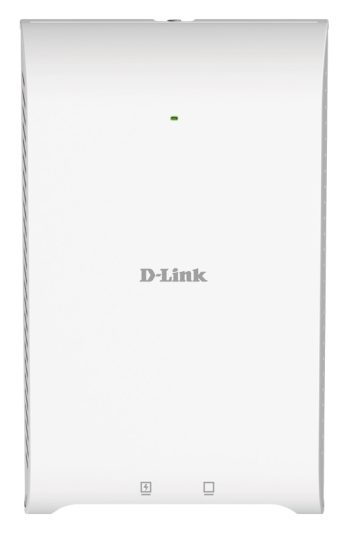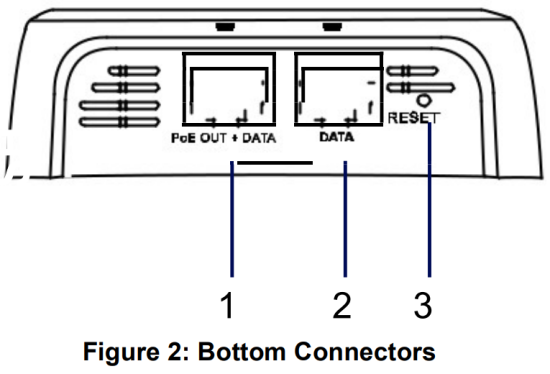D-Link DAP-2622 Nuclias Connect AC1200 Wave 2 Wall-Plated Access Point Installation Guide
D-Link DAP-2622 Nuclias Connect AC1200 Wave 2 Wall-Plated Access Point

Before You Begin
This installation guide provides instructions for installing the DAP-2622 on your network. Additional documentation is also available on the D-Link support website.
- Nuclias Connect Manual: For additional information and instructions on how to configure the device using Nuclias Connect.
- DAP-2622 User Manual: For additional information and instructions on how to configure the device using the web user interface.
Package Contents
This DAP-2622 package includes the following items:
- DAP-2622 Access Point
- Mounting Plate and Hardware
- Quick Start Guide
If any of the above items are damaged or missing, please contact your local D-Link reseller.
Note: No power adapter is supplied with this product. To power the unit, use an 802.3at PoE Switch.
System Requirements
- Computers with Windows®, Macintosh®, or Linux-based operating systems with an installed Ethernet Adapter
- Internet Explorer 11, Safari 7, Firefox 28, or Google Chrome 33 and above (for configuration)
Hardware Overview
LED Indicators
Table 1: LED Description
| # | LED | Description |
| 1 | Power/ Status | Green (Solid) – Device operational Red (Flashing) – Device booting up/Device malfunctioned Red (Solid) – Device boot up has failed |
Interface Connectors

Table 2: Interface Description
| # | Connector | Description |
| 1 | PoE OUT + DATA | Gigabit RJ-45 port for data and Power over Ethernet (PoE) power. Supports a maximum of 12 W. |
| 2 | DATA | Gigabit RJ-45 port for data. |
| 3 | RESET | Press and hold for 20 seconds to factory reset the device. |
Table 3: Interface Description
| # | Connector | Description |
| 1 | LAN (PoE) Port | Gigabit RJ-45 port for data and Power over Ethernet (PoE). |
Installation
Using Power over Ethernet (PoE)
- Use a standard Ethernet cable to connect the LAN (PoE) port on the back of the DAP-2622 to a PoE power source device such as an 802.3at PoE switch.
Configuration
Using Nuclias Connect
The DAP-2622 is designed to be managed through Nuclias Connect. Refer to the Nuclias Connect Manual for detailed configuration instructions.
Manual Configuration
Note: D-Link recommends manually configuring the device before mounting it. The management computer, DHCP server and DAP-2622 must be in the same subnet.
Use one of the following methods to access the web user interface:
Connecting through Ethernet
- Use an Ethernet cable to connect the DAP-2622 to the management computer,or to the switch or router the management computer is connected to.
- Manage the access point from a computer. Enter dap2622.local in the address field of your browser.
- Log in to the administration user interface. The default login information is
Username: admin
Password: admin
Connecting Wirelessly
- Connect the management computer to the default SSID of the DAP-2622, “dlink”.
- Manage the access point from a computer. Enter dap2622.local in the address field of your browser.
- Log in to the administration user interface. The default login information is
Username: admin
Password: admin
Mounting
Mounting on a Solid Wall
For optimal coverage, mount the DAP2622 on the wall. An Ethernet cable running through an electrical wall box should be pre-installed before mounting
- Place the mounting plate over an electrical wall box and mark the location where to drill the holes in the wall. The Ethernet cable should pass through the mounting plate.
- Drill holes on the markings and place the included anchors into the drilled holes.
- Align and place the mounting plate on top of the anchors and use the included screws to secure the mounting plate to the surface.
- Plug the Ethernet cable into the LAN (PoE) port on the rear panel of the device.
- Attach the DAP-2622 to the mounting plate by snapping the device onto the plate and use the Allen key to lock it in at the top.
Appendix – Statements
Federal Communication Commission Interference Statement
This equipment has been tested and found to comply with the limits for a Class B digital device, pursuant to Part 15 of the FCC Rules. These limits are designed to provide reasonable protection against harmful interference in a residential installation. This equipment generates, uses and can radiate radio frequency energy and, if not installed and used in accordance with the instructions, may cause harmful interference to radio communications. However, there is no guarantee that interference w ll not occur in a particular installation. If this equipment does cause harmful interference to radio or television reception, which can be determined by turning the equipment off and on, the user is encouraged to try to correct the interference by one of the following measures:
- Reorient or relocate the receiving antenna.
- Increase the separation between the equipment and receiver.
- Connect the equipment into an outlet on a circuit different from that to which the receiver is connected.
- Consult the dealer or an experienced radio/TV technician for help.
Non-modifications Statement:
Any changes or modifications not expressly approved by the party responsible for compliance could void the user’s authority to operate this equipment.
Caution:
This device complies with Part 15 of the FCC Rules. Operation is subject to the following two conditions:
(1) This device may not cause harmful interference, and (2) this device must accept any interference received, including interference that may cause undesired operation.
This device and its antenna(s) must not be co-located or operating in conjunction with any other antenna or transmitter except in accordance with FCC multi-transmitter product procedures. For product available in the USA/Canada market, only channel 1~11 can be operated. Selection of other channels is not possible
Note
The country code selection is for non-USA models only and is not available to all USA models. Per FCC regulations, all WiFi product marketed in the USA must be fixed to USA operational channels only.c
RF Frequency Requirements
This device is for indoor use only when using all channels in the 5.15 to 5.25 GHz frequency range. High power radars are allocated as primary users of the 5.25 to 5.35 GHz and 5.65 to 5.85 GHz bands. These radar stations can cause interference with and/or damage this device. This device will not operate on channels which overlap the 5600-5650 MHz band. It is restricted to indoor environments only
Radiation Exposure Statement:
This equipment complies with FCC radiation exposure limits set forth for an uncontrolled environment. This equipment should be installed and operated with minimum distance 20cm between the radiator & your body
Ver.2.00(WW)_130x183
2020/10/23